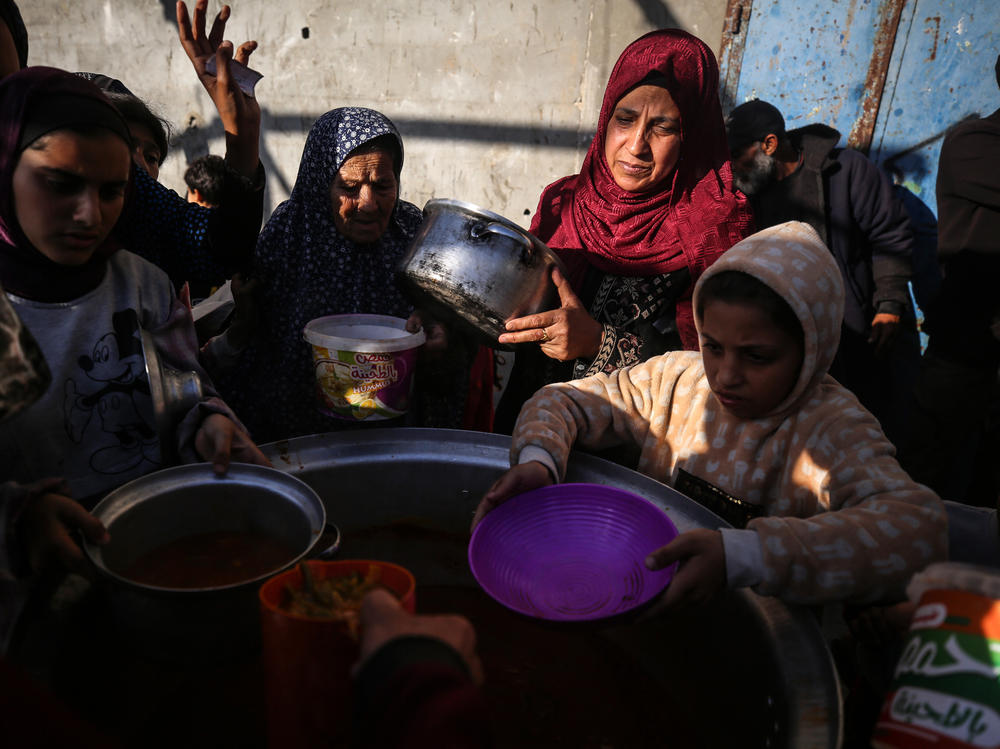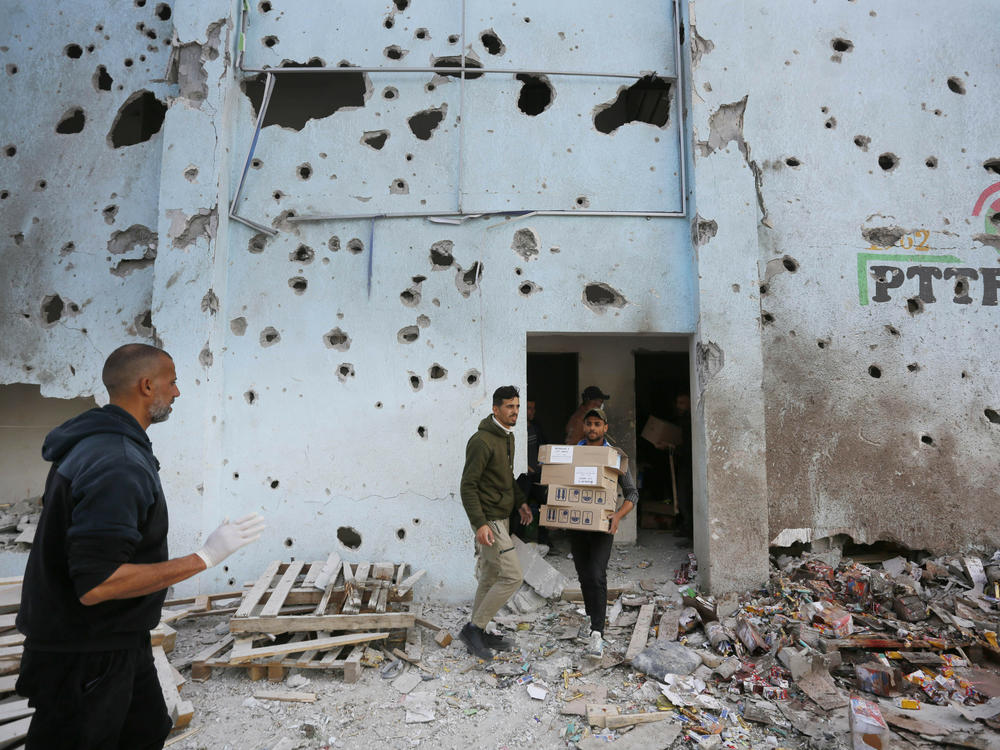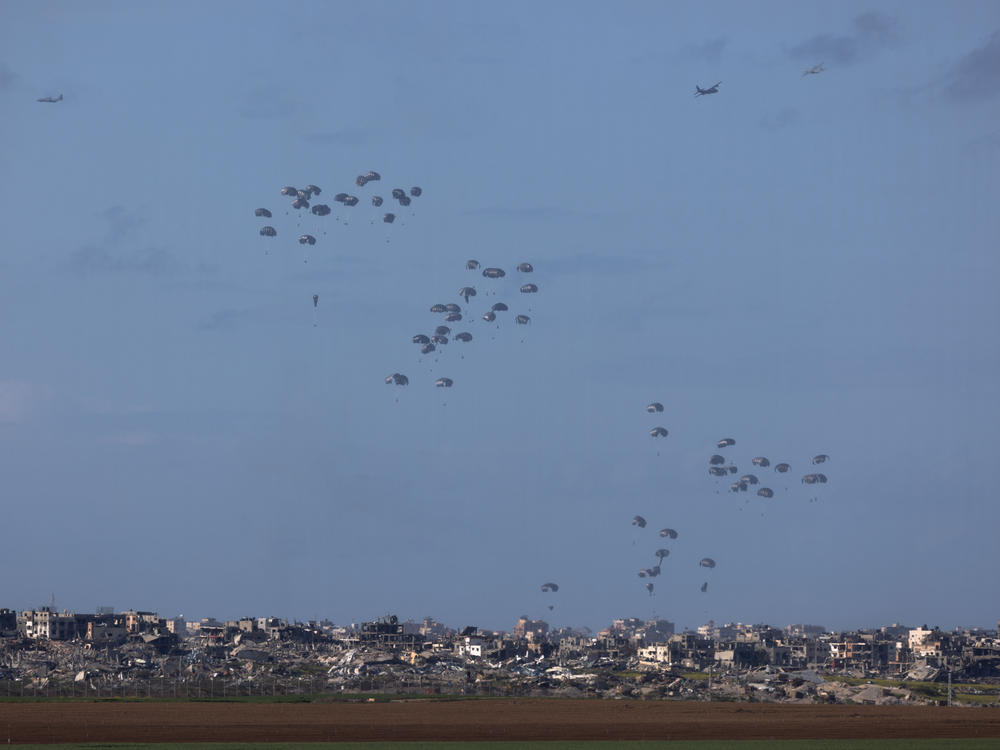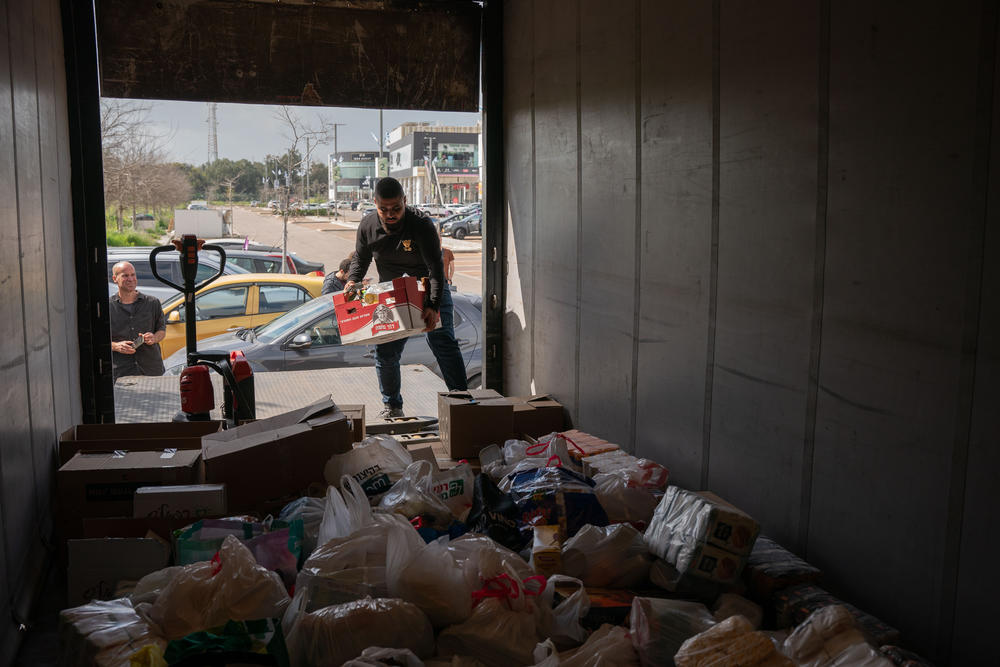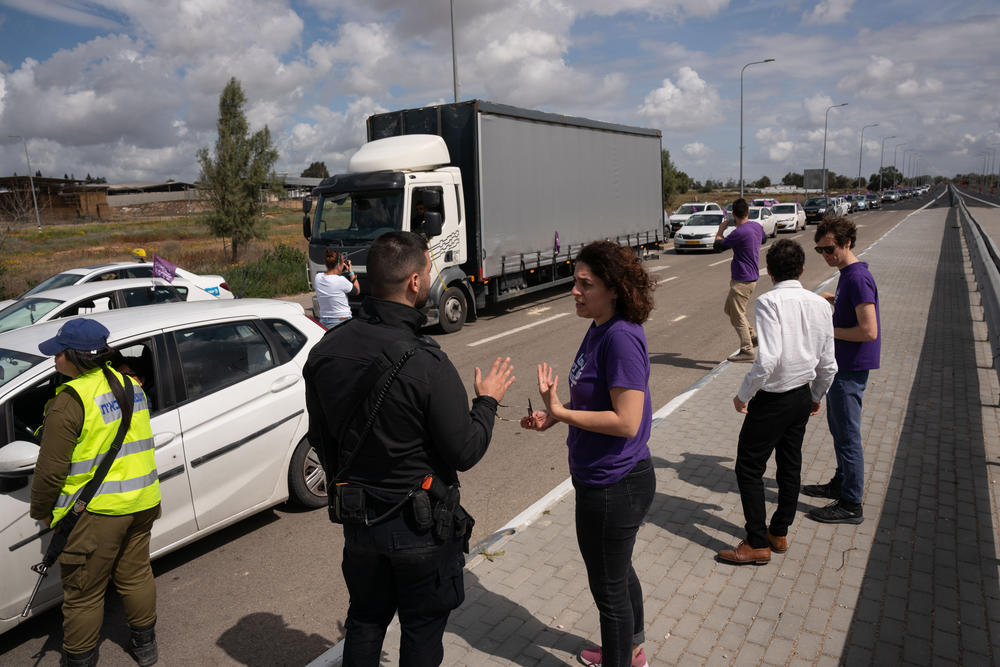Section Branding
Header Content
With aid headed to Gaza, risks remain to getting food to its starving population
Primary Content
NITZANA, Israel-Egypt border — Airdropping aid packages from planes, U.S. military and NGO boats working independently to deliver aid by sea, and now the U.N. food agency has finally managed to get aid in by land. Multiple international efforts are afoot to bring desperately needed food, medicine and other supplies to Palestinians in the besieged Gaza Strip, but significant hurdles and danger to those on the ground remain.
An Israeli strike on a food distribution center in Gaza killed a staff member of the United Nations' Palestinian relief agency, UNRWA, and injured another 22 people, the agency said Wednesday.
Israel's military said it was targeting a member of Hamas' militant wing, accusing him of taking control of humanitarian aid and giving it to Hamas operatives.
An uncle of the man denies Israel's claim and told NPR this person was a police officer in charge of guarding aid. Before his death, Israeli security forces had warned the man to stop his work, his uncle said.
The food center is eastern Rafah, a city in the southern Gaza Strip where more than 1.5 million people are taking shelter.
"Today's attack on one of the very few remaining UNRWA distribution centres in the Gaza Strip comes as food supplies are running out, hunger is widespread and, in some areas, turning into famine," UNRWA Commissioner-General Philippe Lazzarini said in a statement. "Every day, we share the coordinates of all our facilities across the Gaza Strip with parties to the conflict. The Israeli Army received the coordinates including of this facility yesterday [Tuesday]."
As the threat of widespread famine looms, the United States and other countries and nongovernmental groups are working on alternative methods to deliver aid safely to people in Gaza.
Last week, President Biden announced the military will build a floating pier for aid deliveries off Gaza's coast, as his administration has grown frustrated urging the Israeli government to enable humanitarian relief to reach the population in the enclave. But the pier won't be ready for several weeks.
Israel destroyed the Port of Gaza during the war, and the waters along the Gaza Strip are shallow, so there's a logistical challenge to bringing goods ashore from large ships.
In a separate mission, a humanitarian ship is pulling a barge loaded with food for Gaza, which is expected to arrive this week. Humanitarian-chef José Andrés' World Central Kitchen, a charity that provides food in disaster zones, says it is constructing a jetty to unload it and then put it onto trucks for delivery.
The need in Gaza is urgent, says Jamie McGoldrick, the U.N. humanitarian coordinator for the Palestinian territories, warning of a "massive deterioration" if aid doesn't reach people immediately.
"Any supplementary possibility of bringing in aid through either airdrops or by sea is helpful. But the main part of it has to be done by road. That's the only way we can deliver bulk and at scale to populations inside Gaza, especially in the north," McGoldrick told NPR.
Speaking to the U.N. Security Council in New York on Tuesday, Josep Borrell, the European Union's foreign policy chief, said the humanitarian crisis is "man-made, and when we look for alternative ways of providing support by sea, by air, we have to remind that we have to do it because the natural way of providing support through roads is being closed."
"Starvation is being used as a war arm and when we condemned this happening in Ukraine, we have to use the same words for what is happening in Gaza," Borrell said.
An aid delivery breakthrough
On Tuesday, the World Food Programme was able to deliver its first convoy of aid to northern Gaza in three weeks, using an Israeli military road that runs along the Gaza border fence to reach the area.
"With people in northern Gaza on the brink of famine, we need deliveries every day and we need entry points directly into the north," the U.N. food agency said.
The WFP wasn't so fortunate last week: It said it tried and failed to distribute aid to northern Gaza on March 5, in its first attempt since Feb. 20. Israeli soldiers turned away its 14-truck food convoy after a three-hour wait at the Wadi Gaza checkpoint that separates the northern and southern parts of the enclave. After being rerouted, the convoy was stopped by a large crowd of desperate people who looted about 200 tons of food, the U.N. food agency said.
When Israel launched its air, sea and ground offensive, in response to the Hamas-led Oct. 7 attack on the country, it targeted northern Gaza first. The north has remained largely cut off since. But the U.N. estimates up to 300,000 people remain there under some of the worst conditions in Gaza, with little to no access to food and water and barely functioning hospitals.
According to the Health Ministry in Gaza, at least 23 children and four adults have died of malnutrition and dehydration at hospitals in northern Gaza. The World Health Organization has warned of an "explosion" in child deaths if aid doesn't reach people immediately.
Abed Amin, a 35-year-old who lives in Gaza City and takes care of his three sisters, says he and his family have not received any aid since the start of the war over five months ago. Sometimes he borrows money from his friends to buy canned mushrooms or olives at a steep price on the black market. But these days, they mostly grind animal feed to a sort of flour.
"It's anything but flour," Amin says. "You can barely make a dough out of it, can't cook it and can barely swallow it. But it's all there is."
For the past two weeks, the U.S. and other countries have been airdropping aid packages, but experts say airdrops are inefficient and a last resort.
Mass starvation in Gaza has also created a big security problem, where people are desperate for any food, and usually the strongest are able to access what little aid gets in.
Taghreed Al Khoudary, a mother of four daughters in northern Gaza, says before the war she spoiled her children and made whatever they wanted for dinner. Now, she has had to teach her daughters to survive on one loaf of bread a day.
Recently, an airdropped package landed on the roof of her two-story home. Khoudary rushed up and was elated to find boxes of food. Then, she turned around and saw a large crowd behind her, some had climbed up, many of them holding knives and some were even armed, she said.
"It felt like a scene from a zombie movie. Their eyes were laser focused, like they only saw the food packages and nothing else," she says.
"I screamed, 'Please take everything and leave us alone,' " she says, as a big fight broke out.
McGoldrick, the U.N. humanitarian coordinator, says the situation has become a Catch-22.
"What we need to do is flood the north with food so it doesn't become a very prized commodity. If people in the north could see the fact that on a daily basis there was regular supplies of trucks of food, medicine and other key commodities, I think the desperation would not be there. The insecurity wouldn't be there either," McGoldrick says.
For that, McGoldrick says Israel needs to open up more border crossings, increase its ability to do inspections on aid trucks and allow aid groups access to secure roads that the Israeli military uses in northern Gaza.
Israeli protesters have been disrupting aid flow
Aid trucks to Gaza have also been stalled by Israeli protesters, who want nothing to go in until Hamas releases hostages taken from Israel during the Oct. 7 attack.
"The fact that they've had to do airdrops shows that we are succeeding," said Debby Sharon, one of the organizers for the protest at Nitzana crossing on the Egypt-Israel border, where all the trucks heading to Gaza stop for Israeli inspection. The sit-in that day earlier this month prevented any trucks from getting inspected.
Currently aid trucks can enter Gaza either through Egypt's border crossing at Rafah or Israel's Kerem Shalom crossing. But protesters, who have gained support in Israel in recent weeks from some families of hostages, have been blocking aid trucks both at Kerem Shalom and at Nitzana.
"Why are we relying on feeding over 1.5 million displaced people through one gate, when you have disruptions to that gate because of demonstrations that block it for days?" says McGoldrick. He says Israel should open the Ashdod border crossing into northern Gaza.
Israel blames aid organizations
Israel says it's not putting any limits on humanitarian aid.
"Israel works tirelessly on finding ways to get humanitarian aid to the residents of Gaza," says Shimon Friedman, spokesperson for Israel's Coordination of Government Activities in the Territories. "And we've gone through to great lengths to increase our capacity of inspection in order to facilitate additional aid."
Friedman says any problems with the distribution and flow of aid are the fault of aid organizations for not having enough "manpower" to deal with the demand.
But the Association of International Development Agencies, whose members include dozens of nongovernmental aid groups operating in the region, says Israel's Welfare Ministry stopped renewing visas for humanitarian workers in early February.
Human rights groups say Israeli policies undermine humanitarian efforts
Miriam Marmur, the director of public advocacy at Gisha, an Israeli nonprofit organization that monitors the rights of Palestinians with a focus on Gaza, says there are several factors in current Israeli policy that directly affect the flow of aid.
One major issue is that Israel doesn't allow aid agencies to purchase any goods within Israel or the occupied West Bank or to import them through Israeli ports, as part of its post-Oct. 7 policy to cut off Gaza.
"Before Oct. 7, the aid agencies that were active in the area were only sourcing goods through Israel. So, the adjustment of having to purchase all of their goods in Egypt or import goods that they need has in itself been a hindering factor and is impacting aid operations," Marmur says.
Then there is the fuel cap Israel imposes, which affects every aspect of humanitarian operation, including communication, because of the electrical blackout.
McGoldrick says Israeli officials need to understand their responsibility when it comes to the civilian population in Gaza.
"They have the war aims that they have and the humanitarian part of it, I don't think is a priority for them," McGoldrick says.
"They have a responsibility to allow the humanitarians unfettered access. And that's not happening often enough or we have many deconfliction issues," McGoldrick says. "We have many issues that have been notified in advance. At the same time, we get blocked or we get diverted or maintained. We've seen some trucks being actually hit by military fire as well."
Georgios Petropoulos, who heads the U.N. humanitarian coordination sub-office in Gaza, describes what he recently saw driving around in the Gaza Strip as "profoundly grotesque."
"I could see civil defense vehicles annihilated. I saw ambulances cut in half by machine gun fire. I saw primary health care centers shut up, at the same time that you have a war of such acute aggression and violence in such a contained area," Petropoulos says.
Daniel Estrin and Anas Baba contributed reporting.
